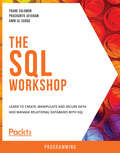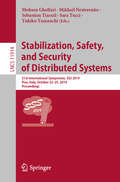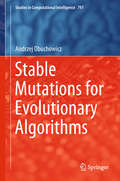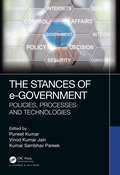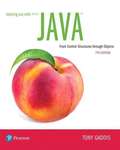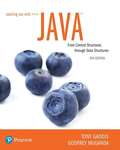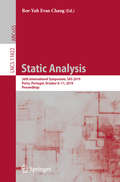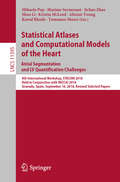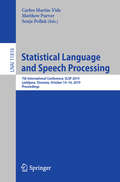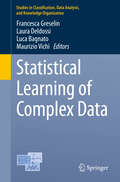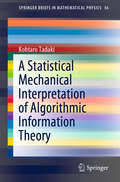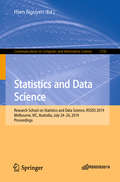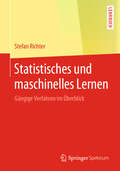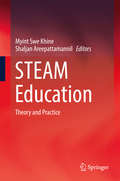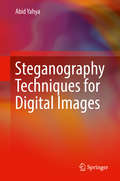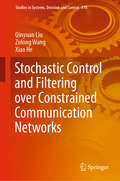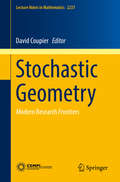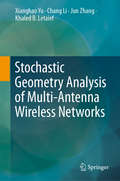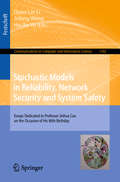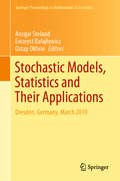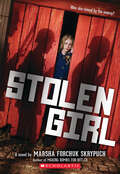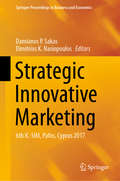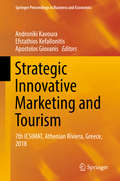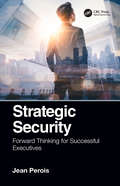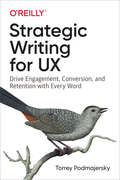- Table View
- List View
The SQL Workshop: A New, Interactive Approach to Learning SQL
by Prashanth Jayaram Frank Solomon Awni Al SaqqaCut through the noise and get real results with a step-by-step approach to learning SQL Key Features A structured, straightforward introduction to SQL for beginners A SQL tutorial with step-by-step exercises and activities that help build key skills Structured to let you progress at your own pace, on your own terms Use your physical print copy to redeem free access to the online interactive edition Book Description You already know you want to learn SQL, and the best way to learn SQL is to learn by doing. The SQL Workshop focuses on building up your SQL database management skills so that you can easily store and retrieve data or become the in-house expert on complex queries. You'll learn from real examples that lead to real results. Throughout The SQL Workshop, you'll take an engaging step-by-step approach to understanding SQL programming. You won't have to sit through any unnecessary theory. If you're short on time you can jump into a single exercise each day or spend an entire weekend learning how to create functions and stored procedures. It's your choice. Learning on your terms, you'll build up and reinforce key skills in a way that feels rewarding. Every physical print copy of The SQL Workshop unlocks access to the interactive edition. With videos detailing all exercises and activities, you'll always have a guided solution. You can also benchmark yourself against assessments, track progress, and receive content updates. You'll even earn a secure credential that you can share and verify online upon completion. It's a premium learning experience that's included with your printed copy. To redeem, follow the instructions located at the start of your book. Fast-paced and direct, The SQL Workshop is the ideal companion for SQL beginners. You'll build and iterate on your code like a software developer, learning along the way. This process means that you'll find that your new skills stick, embedded as best practice. A solid foundation for the years ahead. What you will learn Learn how to create normalized databases Explore how to insert data into tables efficiently Explore various techniques to retrieve data from multiple tables Build advanced queries using techniques like subqueries and views Learn advanced SQL programming techniques such as functions and triggers Who this book is for Our goal at Packt is to help you be successful, in whatever it is you choose to do. The SQL Workshop is an ideal SQL tutorial for the SQL beginner who is just getting started. Pick up a Workshop today, and let Packt help you develop skills that stick with you for life.
Stabilization, Safety, and Security of Distributed Systems: 21st International Symposium, SSS 2019, Pisa, Italy, October 22–25, 2019, Proceedings (Lecture Notes in Computer Science #11914)
by Mohsen Ghaffari Mikhail Nesterenko Sébastien Tixeuil Sara Tucci Yukiko YamauchiThis book constitutes the refereed proceedings of the 21st International Symposium on Stabilization, Safety, and Security of Distributed Systems, SSS 2019, held in Pisa, Italy, in October 2019.The 21 full papers presented were carefully reviewed and selected from 45 submissions. The papers deal with the design and development of distributed systems with a focus on systems that are able to provide guarantees on their structure, performance, and/or security in the face of an adverse operational environment.
Stable Mutations for Evolutionary Algorithms (Studies in Computational Intelligence #797)
by Andrzej ObuchowiczThis book presents a set of theoretical and experimental results that describe the features of the wide family of α-stable distributions (the normal distribution also belongs to this class) and their various applications in the mutation operator of evolutionary algorithms based on real-number representation of the individuals, and, above all, equip these algorithms with features that enrich their effectiveness in solving multi-modal, multi-dimensional global optimization problems. The overall conclusion of the research presented is that the appropriate choice of probabilistic model of the mutation operator for an optimization problem is crucial. Mutation is one of the most important operations in stochastic global optimization algorithms in the n-dimensional real space. It determines the method of search space exploration and exploitation. Most applications of these algorithms employ the normal mutation as a mutation operator. This choice is justified by the central limit theorem but is associated with a set of important limitations. Application of α-stable distributions allows more flexible evolutionary models to be obtained than those with the normal distribution. The book presents theoretical analysis and simulation experiments, which were selected and constructed to expose the most important features of the examined mutation techniques based on α-stable distributions. It allows readers to develop a deeper understanding of evolutionary processes with stable mutations and encourages them to apply these techniques to real-world engineering problems.
The Stances of e-Government: Policies, Processes and Technologies
by Puneet Kumar Vinod Kumar Jain Kumar Sambhav PareekThis book focuses on the three inevitable facets of e-government, namely policies, processes and technologies. The policies discusses the genesis and revitalization of government policies; processes talks about ongoing e-government practices across developing countries; technology reveals the inclusion of novel technologies.
Starting Out With Java: From Control Structures Through Objects (What's New In Computer Science Ser.)
by Tony GaddisIn Starting Out with Java: From Control Structures through Objects , Gaddis covers procedural programming-control structures and methods-before introducing object-oriented programming. As with all Gaddis texts, clear and easy-to-read code listings, concise and practical real-world examples, and an abundance of exercises appear in every chapter.
Starting Out with Java: From Control Structures through Data Structures (What's New in Computer Science)
by Tony Gaddis Godfrey MugandaProvide a step-by-step introduction to programming in Java Starting Out with Java: From Control Structures through Data Structures provides a step-by-step introduction to programming in Java. This text is designed to be used in a 2 or 3 semester sequence and covers everything from the fundamentals of Java programming to algorithms and data structures. As with all Gaddis texts, every chapter contains clear and easy-to-read code listings, concise and practical real-world examples, and an abundance of exercises. With the 4th Edition, JavaFX has replaced Swing as the standard GUI library for Java in chapters that focus on GUI development. The Swing and Applet material from the previous edition is available online.
Static Analysis: 26th International Symposium, SAS 2019, Porto, Portugal, October 8–11, 2019, Proceedings (Lecture Notes in Computer Science #11822)
by Bor-Yuh Evan ChangThis book constitutes the refereed proceedings of the 26th International Symposium on Static Analysis, SAS 2019, held in Porto, Portugal, in October 2019. The 20 regular papers presented in this book were carefully reviewed and selected from 50 submissions. The papers are grouped in topical sections on pointers and dataflow; languages and decidability; numerical; trends: assuring machine learning; synthesis and security; and temporal properties and termination.
Statistical Atlases and Computational Models of the Heart. Atrial Segmentation and LV Quantification Challenges: 9th International Workshop, STACOM 2018, Held in Conjunction with MICCAI 2018, Granada, Spain, September 16, 2018, Revised Selected Papers (Lecture Notes in Computer Science #11395)
by Mihaela Pop Maxime Sermesant Jichao Zhao Shuo Li Kristin McLeod Alistair Young Kawal Rhode Tommaso MansiThis book constitutes the thoroughly refereed post-workshop proceedings of the 9th International Workshop on Statistical Atlases and Computational Models of the Heart: Atrial Segmentation and LV Quantification Challenges, STACOM 2018, held in conjunction with MICCAI 2018, in Granada, Spain, in September 2018. The 52 revised full workshop papers were carefully reviewed and selected from 60 submissions. The topics of the workshop included: cardiac imaging and image processing, machine learning applied to cardiac imaging and image analysis, atlas construction, statistical modelling of cardiac function across different patient populations, cardiac computational physiology, model customization, atlas based functional analysis, ontological schemata for data and results, integrated functional and structural analyses, as well as the pre-clinical and clinical applicability of these methods.
Statistical Language and Speech Processing: 7th International Conference, SLSP 2019, Ljubljana, Slovenia, October 14–16, 2019, Proceedings (Lecture Notes in Computer Science #11816)
by Carlos Martín-Vide Matthew Purver Senja PollakThis book constitutes the proceedings of the 7th International Conference on Statistical Language and Speech Processing, SLSP 2019, held in Ljubljana, Slovenia, in October 2019. The 25 full papers presented together with one invited paper in this volume were carefully reviewed and selected from 48 submissions. They were organized in topical sections named: Dialogue and Spoken Language Understanding; Language Analysis and Generation; Speech Analysis and Synthesis; Speech Recognition; Text Analysis and Classification.
Statistical Learning of Complex Data (Studies in Classification, Data Analysis, and Knowledge Organization)
by Francesca Greselin Laura Deldossi Luca Bagnato Maurizio VichiThis book of peer-reviewed contributions presents the latest findings in classification, statistical learning, data analysis and related areas, including supervised and unsupervised classification, clustering, statistical analysis of mixed-type data, big data analysis, statistical modeling, graphical models and social networks. It covers both methodological aspects as well as applications to a wide range of fields such as economics, architecture, medicine, data management, consumer behavior and the gender gap. In addition, it describes the basic features of the software behind the data analysis results, and provides links to the corresponding codes and data sets where necessary. This book is intended for researchers and practitioners who are interested in the latest developments and applications in the field of data analysis and classification. It gathers selected and peer-reviewed contributions presented at the 11th Scientific Meeting of the Classification and Data Analysis Group of the Italian Statistical Society (CLADAG 2017), held in Milan, Italy, on September 13–15, 2017.
A Statistical Mechanical Interpretation of Algorithmic Information Theory (SpringerBriefs in Mathematical Physics #36)
by Kohtaro TadakiThis book is the first one that provides a solid bridge between algorithmic information theory and statistical mechanics. Algorithmic information theory (AIT) is a theory of program size and recently is also known as algorithmic randomness. AIT provides a framework for characterizing the notion of randomness for an individual object and for studying it closely and comprehensively. In this book, a statistical mechanical interpretation of AIT is introduced while explaining the basic notions and results of AIT to the reader who has an acquaintance with an elementary theory of computation.A simplification of the setting of AIT is the noiseless source coding in information theory. First, in the book, a statistical mechanical interpretation of the noiseless source coding scheme is introduced. It can be seen that the notions in statistical mechanics such as entropy, temperature, and thermal equilibrium are translated into the context of noiseless source coding in a natural manner. Then, the framework of AIT is introduced. On this basis, the introduction of a statistical mechanical interpretation of AIT is begun. Namely, the notion of thermodynamic quantities, such as free energy, energy, and entropy, is introduced into AIT. In the interpretation, the temperature is shown to be equal to the partial randomness of the values of all these thermodynamic quantities, where the notion of partial randomness is a stronger representation of the compression rate measured by means of program-size complexity. Additionally, it is demonstrated that this situation holds for the temperature itself as a thermodynamic quantity. That is, for each of all the thermodynamic quantities above, the computability of its value at temperature T gives a sufficient condition for T to be a fixed point on partial randomness.In this groundbreaking book, the current status of the interpretation from both mathematical and physical points of view is reported. For example, a total statistical mechanical interpretation of AIT that actualizes a perfect correspondence to normal statistical mechanics can be developed by identifying a microcanonical ensemble in the framework of AIT. As a result, the statistical mechanical meaning of the thermodynamic quantities of AIT is clarified. In the book, the close relationship of the interpretation to Landauer's principle is pointed out.
Statistics and Data Science: Research School on Statistics and Data Science, RSSDS 2019, Melbourne, VIC, Australia, July 24–26, 2019, Proceedings (Communications in Computer and Information Science #1150)
by Hien NguyenThis book constitutes the proceedings of the Research School on Statistics and Data Science, RSSDS 2019, held in Melbourne, VIC, Australia, in July 2019. The 11 papers presented in this book were carefully reviewed and selected from 23 submissions. The volume also contains 7 invited talks. The workshop brought together academics, researchers, and industry practitioners of statistics and data science, to discuss numerous advances in the disciplines and their impact on the sciences and society. The topics covered are data analysis, data science, data mining, data visualization, bioinformatics, machine learning, neural networks, statistics, and probability.
Statistisches und maschinelles Lernen: Gängige Verfahren im Überblick
by Stefan RichterDieses Buch verschafft Ihnen einen Überblick über einige der bekanntesten Verfahren des maschinellen Lernens aus der Perspektive der mathematischen Statistik. Nach der Lektüre kennen Sie die jeweils gestellten Forderungen an die Daten sowie deren Vor- und Nachteile und sind daher in der Lage, für ein gegebenes Problem ein geeignetes Verfahren vorzuschlagen. Beweise werden nur dort ausführlich dargestellt oder skizziert, wo sie einen didaktischen Mehrwert bieten – ansonsten wird auf die entsprechenden Fachartikel verwiesen. Für die praktische Anwendung ist ein genaueres Studium des jeweiligen Verfahrens und der entsprechenden Fachliteratur nötig, zu der Sie auf Basis dieses Buchs aber schnell Zugang finden. Das Buch richtet sich an Studierende der Mathematik höheren Semesters, die bereits Vorkenntnisse in Wahrscheinlichkeitstheorie besitzen. Behandelt werden sowohl Methoden des Supervised Learning und Reinforcement Learning als auch des Unsupervised Learning. Der Umfang entspricht einer einsemestrigen vierstündigen Vorlesung. Die einzelnen Kapitel sind weitestgehend unabhängig voneinander lesbar, am Ende jedes Kapitels kann das erworbene Wissen anhand von Übungsaufgaben und durch Implementierung der Verfahren überprüft werden. Quelltexte in der Programmiersprache R stehen auf der Springer-Produktseite zum Buch zur Verfügung.
STEAM Education: Theory and Practice
by Myint Swe Khine Shaljan AreepattamannilThis book looks at the value of integrating the arts and sciences in the school curriculum. It argues that this will help students further their understanding of analytical concepts through the use of creativity. The authors illustrate how schools can work towards presenting common practices, concepts, and content. Coverage features case studies and lessons learned from classrooms across the United States.The notion of STEAM (Science, Technology, Engineering, Arts, and Mathematics) is an emerging discipline unique in its desire to provide a well-rounded approach to education. The chapters of this volume examine STEAM in a variety of settings, from kindergarten to higher education. Readers will learn about the practical considerations involved when introducing the arts and creativity into traditionally left brain processes. This includes best practices for creating and sustaining successful STEAM initiatives in any school, college, or university. For instance, one chapter discusses novel approaches to teach writing with the scientific method in order to help students better present their ideas. The authors also detail how the arts can engage more diverse learners, including students who are not traditionally interested in STEM subjects. They provide three concrete examples of classroom-tested inquiries: designing a prosthetic arm for a child, making a paleontology investigation, and taking a closer look at the arts within roller coaster engineering. This book is an invaluable resource for teachers and teacher trainers, university faculty, researchers, and school administrators. It will also be of interest to science, mathematics, engineering, computer science, information technology, arts and design and technology teachers.
Steganography Techniques for Digital Images
by Abid YahyaThis book covers newly developed and novel Steganography techniques and algorithms. The book outlines techniques to provide security to a variety of applications using Steganography, with the goal of both hindering an adversary from decoding a hidden message, and also preventing an adversary from suspecting the existence of covert communications. The book looks into applying these newly designed and improved algorithms to provide a new and efficient Steganographic system, called Characteristic Region-Based Image Steganography (CR-BIS). The algorithms combine both the robustness of the Speeded-Up Robust Features technique (SURF) and Discrete Wavelet Transform (DWT) to achieve characteristic region Steganography synchronization. The book also touches on how to avoid hiding data in the whole image by dynamically selecting characteristic regions for the process of embedding. Applies and discusses innovative techniques for hiding text in a digital image file or even using it as a key to the encryption;Provides a variety of methods to achieve characteristic region Steganography synchronization;Shows how Steganography improves upon cryptography by using obscurity features.
Stochastic Control and Filtering over Constrained Communication Networks (Studies in Systems, Decision and Control #178)
by Qinyuan Liu Zidong Wang Xiao HeStochastic Control and Filtering over Constrained Communication Networks presents up-to-date research developments and novel methodologies on stochastic control and filtering for networked systems under constrained communication networks. It provides a framework of optimal controller/filter design, resilient filter design, stability and performance analysis for the systems considered, subject to various kinds of communication constraints, including signal-to-noise constraints, bandwidth constraints, and packet drops. Several techniques are employed to develop the controllers and filters desired, including:recursive Riccati equations;matrix decomposition;optimal estimation theory; andmathematical optimization methods.Readers will benefit from the book’s new concepts, models and methodologies that have practical significance in control engineering and signal processing. Stochastic Control and Filtering over Constrained Communication Networks is a practical research reference for engineers dealing with networked control and filtering problems. It is also of interest to academics and students working in control and communication networks.
Stochastic Geometry: Modern Research Frontiers (Lecture Notes in Mathematics #2237)
by David CoupierThis volume offers a unique and accessible overview of the most active fields in Stochastic Geometry, up to the frontiers of recent research. Since 2014, the yearly meeting of the French research structure GDR GeoSto has been preceded by two introductory courses. This book contains five of these introductory lectures. The first chapter is a historically motivated introduction to Stochastic Geometry which relates four classical problems (the Buffon needle problem, the Bertrand paradox, the Sylvester four-point problem and the bicycle wheel problem) to current topics. The remaining chapters give an application motivated introduction to contemporary Stochastic Geometry, each one devoted to a particular branch of the subject: understanding spatial point patterns through intensity and conditional intensities; stochastic methods for image analysis; random fields and scale invariance; and the theory of Gibbs point processes. Exposing readers to a rich theory, this book will encourage further exploration of the subject and its wide applications.
Stochastic Geometry Analysis of Multi-Antenna Wireless Networks
by Xianghao Yu Chang Li Jun Zhang Khaled B. LetaiefThis book presents a unified framework for the tractable analysis of large-scale, multi-antenna wireless networks using stochastic geometry. This mathematical analysis is essential for assessing and understanding the performance of complicated multi-antenna networks, which are one of the foundations of 5G and beyond networks to meet the ever-increasing demands for network capacity. Describing the salient properties of the framework, which makes the analysis of multi-antenna networks comparable to that of their single-antenna counterparts, the book discusses effective design approaches that do not require complex system-level simulations. It also includes various application examples with different multi-antenna network models to illustrate the framework’s effectiveness.
Stochastic Models in Reliability, Network Security and System Safety: Essays Dedicated to Professor Jinhua Cao on the Occasion of His 80th Birthday (Communications in Computer and Information Science #1102)
by Quan-Lin Li Jinting Wang Hai-Bo YuThis book is dedicated to Jinhua Cao on the occasion of his 80th birthday. Jinhua Cao is one of the most famous reliability theorists. His main contributions include: published over 100 influential scientific papers; published an interesting reliability book in Chinese in 1986, which has greatly influenced the reliability of education, academic research and engineering applications in China; initiated and organized Reliability Professional Society of China (the first part of Operations Research Society of China) since 1981. The high admiration that Professor Cao enjoys in the reliability community all over the world was witnessed by the enthusiastic response of each contributor in this book. The contributors are leading researchers with diverse research perspectives. The research areas of the book iclude a broad range of topics related to reliability models, queueing theory, manufacturing systems, supply chain finance, risk management, Markov decision processes, blockchain and so forth.The book consists of a brief Preface describing the main achievements of Professor Cao; followed by congratulations from Professors Way Kuo and Wei Wayne Li, and by Operations Research Society of China, and Reliability Professional Society of China; and further followed by 25 articles roughly grouped together. Most of the articles are written in a style understandable to a wide audience. This book is useful to anyone interested in recent developments in reliability, network security, system safety, and their stochastic modeling and analysis.
Stochastic Models, Statistics and Their Applications: Dresden, Germany, March 2019 (Springer Proceedings in Mathematics & Statistics #294)
by Ansgar Steland Ewaryst Rafajłowicz Ostap OkhrinThis volume presents selected and peer-reviewed contributions from the 14th Workshop on Stochastic Models, Statistics and Their Applications, held in Dresden, Germany, on March 6-8, 2019. Addressing the needs of theoretical and applied researchers alike, the contributions provide an overview of the latest advances and trends in the areas of mathematical statistics and applied probability, and their applications to high-dimensional statistics, econometrics and time series analysis, statistics for stochastic processes, statistical machine learning, big data and data science, random matrix theory, quality control, change-point analysis and detection, finance, copulas, survival analysis and reliability, sequential experiments, empirical processes, and microsimulations. As the book demonstrates, stochastic models and related statistical procedures and algorithms are essential to more comprehensively understanding and solving present-day problems arising in e.g. the natural sciences, machine learning, data science, engineering, image analysis, genetics, econometrics and finance.
Stolen Girl (Scholastic Press Novels Ser.)
by Marsha Forchuk SkrypuchNadia is haunted by World War II. Her memories of the war are messy, coming back to her in pieces and flashes she can't control. Though her adoptive mother says they are safe now, Nadia's flashbacks keep coming.Sometimes she remembers running, hunger, and isolation. But other times she remembers living with a German family, and attending big rallies where she was praised for her light hair and blue eyes. The puzzle pieces don't quite fit together, and Nadia is scared by what might be true. Could she have been raised by Nazis? Were they her real family? What part did she play in the war?What Nadia finally discovers about her own history will shock her. But only when she understands the past can she truly face her future.Inspired by startling true events, Marsha Forchuk Skrypuch delivers a gripping and poignant story of one girl's determination to uncover her truth.
Strategic Innovative Marketing: 6th IC-SIM, Pafos, Cyprus 2017 (Springer Proceedings in Business and Economics)
by Damianos P. Sakas Dimitrios K. NasiopoulosThis proceedings volume highlights cutting-edge approaches for contemporary issues evolved in strategic marketing and the integration of theory and practice. It focuses on strategic research and innovative activities in marketing that can be used in everyday operations. The contributions have been divided into eight sections, grouping emerging marketing technologies together in a close examination of practices, problems and trends. The first section examines management challenges which influence societies, cultures, networks, organizations, teams, and individuals. It emphasizes ways business processes foster innovation and facilitate management transitions from dominant structures to more evolutionary, developmental paradigms. The second section discusses the benefits and guidelines to implementation of green marketing strategies. The following section pursues new perspectives of the role of location in marketing and its impact on consumer well-being. The next section explores the impacts of user generated content (UGC) on marketing theories and practice, which is followed by a section identifying how market-based assets can contribute to a sustainable competitive advantage. The sixth section covers understanding consumer perception to make marketing decisions. The final sections promote the use of business informatics and modeling in marketing and also the development of integrating information management in ways that change how people use information to engage in knowledge focused activities. The papers from the proceedings of the 6th International Conference on Strategic Innovative Marketing (IC-SIM 2017) have been written by scientists, researchers, practitioners and students that demonstrate a special orientation in strategic marketing, all of whom aspire to be ahead of the curve based on the pillars of innovation. This proceedings volume shares their recent contributions to the field and showcases their exchange of insights on strategic issues in the science of innovation marketing.
Strategic Innovative Marketing and Tourism: 7th ICSIMAT, Athenian Riviera, Greece, 2018 (Springer Proceedings in Business and Economics)
by Androniki Kavoura Efstathios Kefallonitis Apostolos GiovanisThis book covers a very broad range of topics in marketing, communication, and tourism, focusing especially on new perspectives and technologies that promise to influence the future direction of marketing research and practice in a digital and innovational era. Among the areas covered are product and brand management, strategic marketing, B2B marketing and sales management, international marketing, business communication and advertising, digital and social marketing, tourism and hospitality marketing and management, destination branding and cultural management, and event marketing. The book comprises the proceedings of the International Conference on Strategic Innovative Marketing and Tourism (ICSIMAT) 2018, where researchers, academics, and government and industry practitioners from around the world came together to discuss best practices, the latest research, new paradigms, and advances in theory. It will be of interest to a wide audience, including members of the academic community, MSc and PhD students, and marketing and tourism professionals.
Strategic Security: Forward Thinking for Successful Executives
by Jean PeroisStrategic Security will help security managers, and those aspiring to the position, to think strategically about their job, the culture of their workplace, and the nature of security planning and implementation. Security professionals tend to focus on the immediate (the urgent) rather than the important and essential—too often serving as "firefighters" rather than strategists. This book will help professionals consider their roles, and structure their tasks through a strategic approach without neglecting their career objectives. Few security management books for professionals in the field focus on corporate or industrial security from a strategic perspective. Books on the market normally provide "recipes," methods or guidelines to develop, plans, policies or procedures. However, many do so without taking into account the personal element that is supposed to apply these methods. In this book, the authors helps readers to consider their own career development in parallel with establishing their organisation security programme. This is fundamental to becoming, and serving as, a quality, effective manager. The element of considering career objectives as part-and-parcel to this is both unique to only this book and vital for long-term career success. The author delineates what makes strategic thinking different in a corporate and security environment. While strategy is crucial in the running of a company, the traditional attitude towards security is that it has to fix issues quickly and at low cost. This is an attitude that no other department would tolerate, but because of its image, security departments sometimes have major issues with buy-in and from top-management. The book covers the necessary level of strategic thinking to put their ideas into practice. Once this is achieved, the strategic process is explained, including the need to build the different steps into this process—and into the overarching business goals of the organisation—will be demonstrated. The book provides numerous hand-on examples of how to formulate and execute the strategic master plan for the organization. The authors draws on his extensive experience and successes to serve as a valuable resource to all security professionals looking to advance their careers in the field.
Strategic Writing for UX: Drive Engagement, Conversion, and Retention with Every Word
by Torrey PodmajerskyWhen you depend on users to perform specific actions—like buying tickets, playing a game, or riding public transit—well-placed words are most effective. But how do you choose the right words? And how do you know if they work? With this practical book, you’ll learn how to write strategically for UX, using tools to build foundational pieces for UI text and UX voice strategy.UX content strategist Torrey Podmajersky provides strategies for converting, engaging, supporting, and re-attracting users. You’ll use frameworks and patterns for content, methods to measure the content’s effectiveness, and processes to create the collaboration necessary for success. You’ll also structure your voice throughout so that the brand is easily recognizable to its audience.Learn how UX content works with the software development lifecycleUse a framework to align the UX content with product principlesExplore content-first design to root UX text in conversationLearn how UX text patterns work with different voicesProduce text that’s purposeful, concise, conversational, and clear
